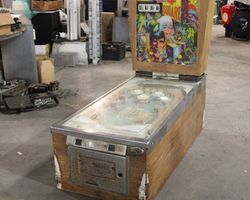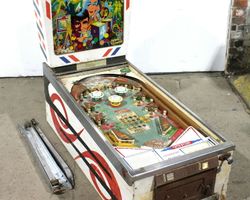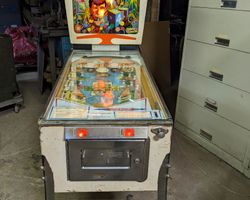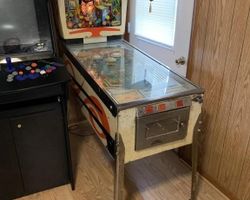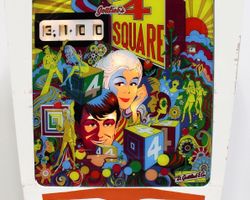4 Square
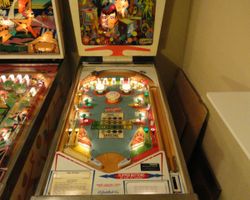
Average Prices: USD $300 to $600
Produced: June, 1971
Production Run: 2,200 units
Machine Type: Electro-mechanical
Players: 1
Design by: Ed Krynski
Art by: Gordon Morison
Pinball machines of the early 1970s often captured the vibrant cultural shifts of their era. Among them, D. Gottlieb & Co.'s "4 Square," released in June 1971, stands as a distinct example of electro-mechanical (EM) design. With a production run of 2,200 units, model number 302, 4 Square emerged from a period of significant innovation within the pinball industry, yet it retained the fundamental mechanical principles that defined the EM experience.
The machine's genesis was overseen by a team of skilled contributors at Gottlieb. The foundational game design was conceived by Ed Krynski, a designer known for his intuitive and engaging layouts. Complementing Krynski's design was the visual artistry of Gordon Morison, whose work provided 4 Square with its distinctive aesthetic. Morison's art for 4 Square leaned into the psychedelic and mod styles prevalent in the early 70s, featuring imagery of dancing figures, expressions of happiness, and visual cues suggesting music, all contributing to a dynamic and visually appealing theme. Its release as a one-player game underscored the design's focus on individual player challenge and high-score pursuit. An interesting point of trivia for enthusiasts is that 4 Square has a direct sibling in Gottlieb's 1971 'Astro,' which served as its add-a-ball counterpart, featuring a different art package but sharing the same playfield layout and core mechanics. This shared lineage highlights a common practice in EM production, where a successful playfield design could be re-imagined with subtle variations to offer different rule sets or appeal to slightly varied markets.
Signature Features and Design
4 Square embodies the core principles of EM pinball, relying on mechanical ingenuity rather than complex electronic systems. Its signature features are defined by their tactile and auditory feedback, characteristic of games from this era. The machine operates with mechanical score reels, which spin with a satisfying clatter, displaying scores up to 9,999 points. A manually operated plunger initiates each ball, demanding a precise touch to set the ball's trajectory.
Central to 4 Square's unique feel are its two short flippers. At approximately 2 inches in length, these flippers are significantly shorter than those found on many other machines, presenting a unique challenge that demands precise timing and a refined sense of ball control. This design choice contributes to a more reactive and less forgiving gameplay style, compelling players to master shot accuracy.
Visually, 4 Square is defined by Gordon Morison's artwork. The backglass particularly captures the essence of the early 1970s with its psychedelic influences and dynamic depiction of figures in motion, evoking a sense of celebration and rhythm. This artistic direction reinforces the machine's theme of dancing, happiness, and music, providing a cohesive visual identity that is both captivating and representative of its historical context. The playfield artwork, while more functional, maintains a consistent color palette and graphic style, integrating the theme subtly into the game's objectives.
Playfield and Mechanics
The 4 Square playfield presents an open layout, a design philosophy often seen in EM machines. While appearing deceptively simple at first glance, this openness fosters a swift and sometimes unpredictable ball flow. The primary interactive elements are strategically placed to encourage dynamic play and require focused shots.
At the heart of the playfield are eight standup targets, crucial for advancing the game's core objectives. These targets are often arranged in a manner that requires careful aim to hit specific ones while avoiding others. Three pop bumpers provide chaotic redirection, sending the ball ricocheting across the upper playfield. Their robust action is a hallmark of Gottlieb EM designs, creating moments of intense, rapid scoring as the ball bounces between them. Below these, two slingshots on either side of the flippers provide additional lateral propulsion, kicking the ball back into the action or setting up dangerous drains.
The arrangement of targets and rollovers across the playfield ensures that a ball in motion is consistently interacting with elements, maintaining a high level of engagement. The flow of 4 Square is designed to keep the ball moving, often at a high velocity, which, combined with the short flippers, necessitates quick reflexes. The overall aesthetic of the playfield is clean and uncluttered, allowing the vibrant colors of Morison's artwork to stand out. The lighting, while simple by modern standards, effectively highlights active targets and scoring opportunities, guiding the player's attention without overwhelming the visual presentation. This design philosophy emphasizes direct interaction with the ball and targets, allowing for a pure pinball experience.
Gameplay Dynamics
The gameplay of 4 Square is characterized by its elegant simplicity, yet it offers considerable depth for those willing to master its nuances. The primary objective revolves around completing sequences of numbered targets, typically 1-2-3-4. Successfully hitting these targets in order, or illuminating them through various playfield interactions, is the key to advancing.
The scoring system is straightforward but rewarding. Each target hit contributes points, and strategic shots can lead to compound scoring, where hitting specific combinations or sequences of targets multiplies point values. The maximum displayed point score on 4 Square is 9,999 points, a common limit for EM machines that necessitates resetting the score reels upon reaching the maximum.
The ultimate goal for players is to light the "Special" feature, which typically awards a free game. This sought-after reward provides a powerful incentive for skilled play and is usually achieved by completing the number sequences multiple times or by achieving specific scoring thresholds. 4 Square demands a high degree of skill, particularly due to its short flippers. Accurate shots are paramount, as even a slight misjudgment can send the ball careening into an undesirable area or directly down the drain. Nudging, a subtle but crucial technique in EM pinball, is also a significant advantage, allowing players to influence the ball's trajectory and prevent drains, adding another layer of physical interaction to the game. The interplay of fast ball speeds, strategic target hits, and the challenge posed by the flippers creates a gameplay loop that is both challenging and highly engaging.
Reception and Legacy
4 Square holds a notable place in the history of Gottlieb's electro-mechanical machines, receiving generally positive feedback from the pinball community. Its average rating often places it high among EM titles, a testament to its enduring appeal.
A significant strength of 4 Square lies in its gameplay. Reviewers frequently praise its simple yet addictive rules, particularly the pursuit of completing the 1-2-3-4 number sequences to achieve the coveted "Special." Despite its fundamental mechanics, the game offers a considerable challenge, keeping players engaged and prompting repeated plays. Its fast-paced nature is often highlighted, a characteristic sometimes amplified by a steeper playfield angle or strong flipper power, contributing to an exhilarating experience. The "Special" feature, alongside compound scoring, provides a satisfying sense of accomplishment, rewarding precise and skilled play. The game's reliance on accurate shots and effective nudging skills further solidifies its reputation as a skill-based machine.
The aesthetic presentation of 4 Square is also consistently well-regarded. Gordon Morison's artwork, especially on the backglass, is celebrated for its retro, psychedelic, or "mod" style, encapsulating the early 1970s era in which it was produced. The open playfield layout, while initially appearing straightforward, is often cited as a deceptive design that effectively draws players into the game's flow. The specific features, such as the two short flippers, are often seen as contributing to a unique and demanding challenge, while the numerous targets and a well-arranged set of pop bumpers are appreciated for their contribution to dynamic gameplay.
However, some perspectives note areas where 4 Square differs from more complex designs. The open playfield can sometimes be perceived as too barren or "unfinished" by those accustomed to later, more feature-rich machines, and the absence of elaborate toys is a common observation for EM games in general. The short flippers, while a source of challenge for some, can also be a point of frustration for others. A few opinions also suggest that the backglass theme, while visually striking, doesn't always feel entirely integrated with the playfield's gameplay mechanics.
Despite these minor points, the overall sentiment towards 4 Square remains overwhelmingly positive. It is widely considered a fun, challenging, and rewarding experience that encapsulates the essence of classic EM pinball. Many enthusiasts express a desire to own or retain the machine if they possess it, frequently recommending it to others as a game that "hooks you in and keeps you there." Its legacy is defined by its ability to provide a pure, skill-focused pinball experience, cementing its place as a cherished example of Gottlieb's EM era.
Sponsored Links
 Ebay Listings
Ebay Listings
 Auction Results
Auction Results
| Cost | Location | Date |
|---|---|---|
| GBP £560 |  Leicester, United Kingdom Leicester, United Kingdom |
01 November, 2023 |
| USD $700 |  Iowa, United States Iowa, United States |
19 October, 2023 |
| USD $300 |  Kentucky, United States Kentucky, United States |
20 February, 2023 |
| USD $300 |  Illinois, United States Illinois, United States |
30 January, 2023 |
| USD $760 |  Pennsylvania, United States Pennsylvania, United States |
22 August, 2022 |
| USD $400 |  Maryland, United States Maryland, United States |
09 June, 2022 |
| CAD $800 |  Canada Canada |
08 November, 2021 |
| USD $710 |  United States United States |
24 October, 2021 |
| GBP £310 |  Cirencester, United Kingdom Cirencester, United Kingdom |
14 July, 2021 |
| GBP £370 |  Sittingbourne, United Kingdom Sittingbourne, United Kingdom |
10 June, 2021 |


Private Policy · Search Website · Contact Us
As an eBay Partner, we may earn a commission from qualifying purchases made through links on this site, at no additional cost to you.
All trademarks and copyrighted materials remain property of their respective owners. All other content copyright 2007 - 2025 Pinpedia.

